History of Glacial Varve Chronology: Eastern North America
Gerard De Geer in North America
Gerard De Geer visited the northeastern United States prior to 1900 and was able to assess the potential of varve chronology in North America. Taking advantage of contacts at Columbia University and Dartmouth College, De Geer assembled an expedition to North America in 1920 in an attempt to compile American varve sequences that would overlap and possibly match the Swedish Varve Chronology or Swedish Time Scale.
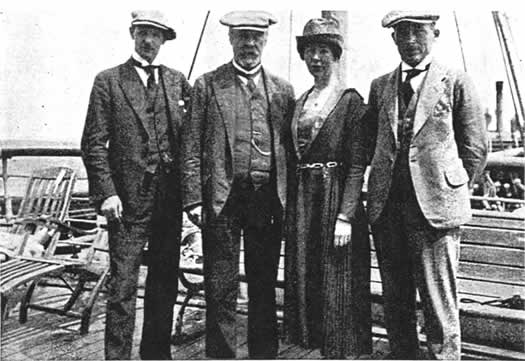
Participants of the 1920 expedition to North America were (left to right above) Ragnar Lid�n, Gerard De Geer, Ebba Hult De Geer, and Ernst V. Antevs (from De Geer, 1940). Ernst Antevs would almost single-handedly compile all of the varve sequences we have in the U.S. and Canada today. He would also never return to Sweden and he would sharply criticize De Geer's attempted trans-Atlantic and inter-hemispheric varve correlations (Antevs, 1931a, 1935, 1954).
Glacial Lakes in the Northeastern U.S.
The prospects of creating a long varve chronology in New England and New York were good because there were many large north-south trending glacial lakes that existed through much of the period of deglaciation (see map below). In addition to the key lakes shown on this map there are many other lakes extending from the maximum extent of glaciation in the south into Quebec from which many short varve sequences were created.
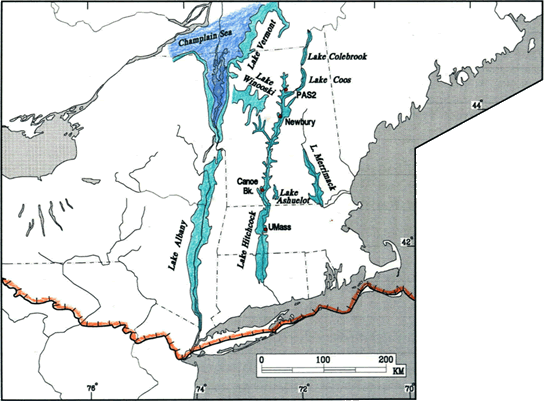
There were several long varve sequences created in the northeastern U.S. in the 1920's by Antevs (1922, 1928) and Chester Reeds at the Museum of Natural History in New York (1926, Lake Hackensack in New Jersey only). Varve sequences from the 1920's were reported as average thickness results from matching varve records at many exposures. In addition, thicknesses of individual varves at some exposures, where they appeared to be abnormal as compared to their thickness at other exposures, were omitted from the compilation. These averaged and filtered records were referred to by Antevs as "normal curves".
Critical sequences in New England are the lower and upper Connecticut varves. These varve records are mostly based on measurements in the Connecticut Valley of western New England but incorporate correlations of varve records in the Merrimack Valley of southern NH, Lake Ashuelot in southwestern NH, the Passumpsic Valley in northern VT, Lake Winooski in western VT, and the Hudson Valley of New York. We refer to these sequences today as the New England Varve Chronology (NEVC). They were arbitrarily numbered beginning with the oldest varve in the southern end of the lower Connecticut varves as varve 2701. Antevs could not find a match or overlap of varves in the lower and upper Connecticut sequences and proposed an arbitrary 248-yr gap, here called the Claremont Gap, that separates the two sequences. Varves in the upper Connecticut sequence begin with varve 6601. A major research objective today is to find and sample varve exposures in the Hudson, Connecticut, or upper Merrimack Valleys that will span the gap and consolidate the separate varve sequences.
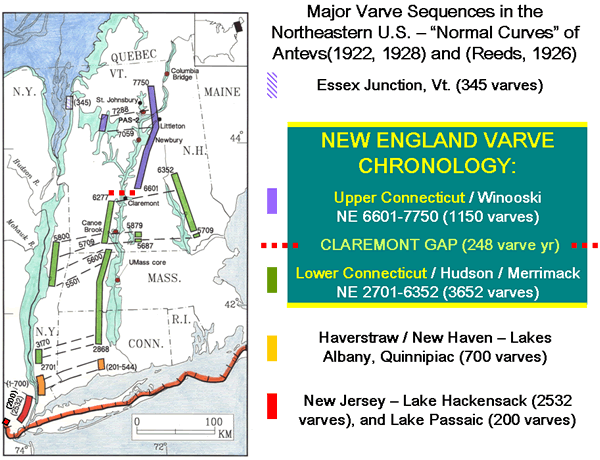
Antevs compiled the upper Connecticut varves to varve 7750 (Antevs, 1928) but at one exposure near Newbury, VT he counted an additional ~750 varves. This section would later be used by geophysicists trying to assemble one of the first records of geomagnetic secular variation from magnetic measurements of the varved clay and silt (Johnson et al., 1948). In the 1990's Jack Ridge and his students at Tufts University found Antevs' Newbury section (Antevs, 1922, location 73) and measured the entire exposure. Using magnified digital images of partially dried cores collected at the outcrop the New England Varve Chronology was extended to varve 8679 (Ridge and Toll, 1999).
Across New England and Canada, in such places as southeastern Massachusetts, the Narragansett Basin of Rhode Island, southern Connecticut, northern Vermont, and Quebec, many short varve records were compiled by Antevs (1928) but they have not been linked to the NEVC. Many additional varve sequences from long-lived glacial lakes in New Jersey, New York, New England, and Quebec have not been studied. This provides the potential for spanning the entire period of late Wisconsinan ice recession from the terminal glacial position to Canada with a single long varve chronology.
Two characteristics of the varve sequences in the northeastern U.S. are important when considering the use of the varve chronologies for correlation or as stable time lines:
- Patterns of varve thickness in records of single varve exposures are extremely reproducible and easily matched from exposure to exposure. This intra-basinal matching was a critical part of the original formulation of the major varve sequences and "normal curves" in the 1920's. Where varve records overlap, the matching of varve records is critical to removing mistakes caused by missing couplets, sediment deformation, or uncertainties in counting and measurement at single outcrops. Intra-basinal matching has allowed the determination of exact varve ages of fossils and samples for radiocarbon dating.
- Patterns of thickness change in varve records from drainage basins that are not hydrologically connected in New England to New York are easily matched year to year. The inter-basinal matches are the foundation of regional correlations as they relate to the glacial history of the northeastern U.S. This characteristic, as much as any other empirical observation, suggests that the varve records are truly annual. The inter-basinal matches have more recently become important for identifying major flood events recorded in single basins.
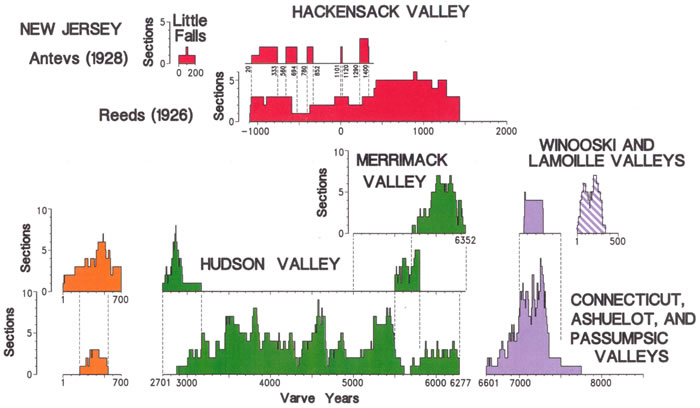
The histograms show the number of outcrops measured to compile the major varve records and "normal curves" in the northeastern U.S. (from Ridge et al., 1999)
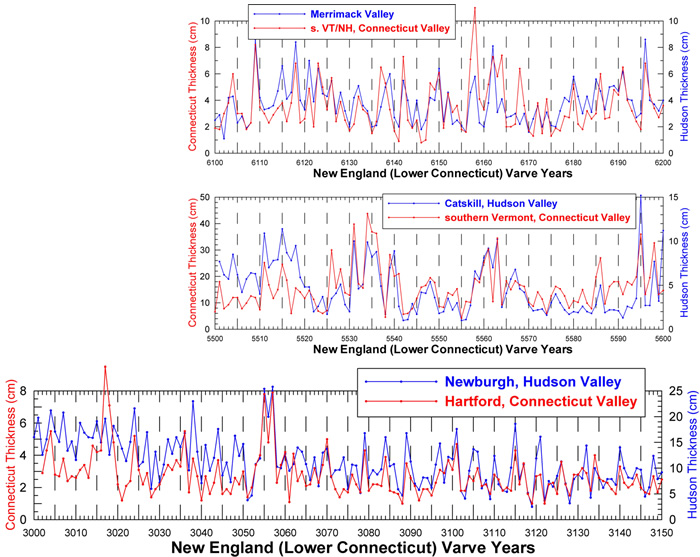
Matching varve series from separate basins. Top: Connecticut Valley, southern VT/NH vs. Merrimack Valley, NH; Middle: Connecticut Valley, southern VT vs. Hudson Valley near Catskill, NY; Bottom: Connecticut Valley near Hartford, CT vs. Hudson Valley near Newburgh, NY
Ice Recession in the Northeastern U.S.: Chronology
1920's
In addition to assembling long varve records in the Connecticut, Merrimack, Hudson, and Winooski valleys, Antevs was able to relate the New England Varve Chronology to the time of deglaciation. This resulted in a map showing the positions of known end moraines in the northeastern U.S. and the age of deglaciation in selected areas plotted according to varve years. The map became possible as basal varves resting on till in the Connecticut Valley where identified according to their varve number in the New England Varve Chronology. The ages of basal varves were progressively younger to the north, depicting a consistent south to north onlapping of the varve sequence above underlying till. From this data Antevs' map shows a consistent south to north ice margin recession during the last deglaciation and rates of ice recession were calculated. Antevs referred to the orderly south to north retreat of the ice margin as simply "recession" of the ice sheet.
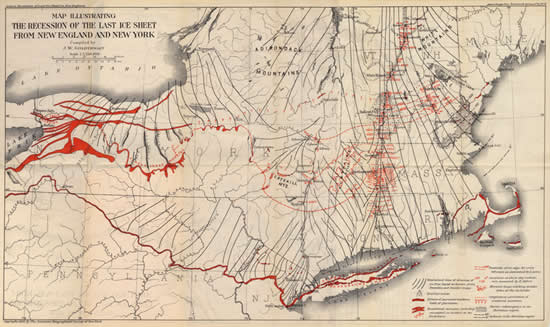
Plate VI of Antevs (1922)
1930's
Beginning in the 1930's several things happened to cause geologists in North America to have doubts about the validity of the New England Varve Chronology as a chronologic tool and as an instrument for determining the history of deglaciation.
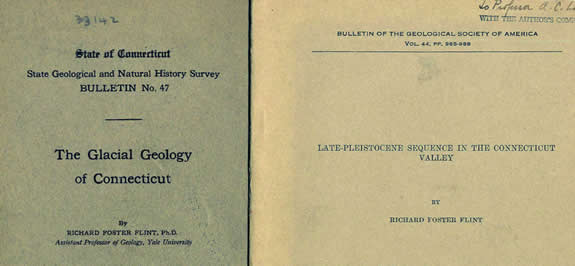
Flint, 1930 (Left) and Flint, 1933 (Right)
Papers published by Richard Foster Flint (1929, 1930, 1932, 1933) interpreted the deglaciation of southern New England as having occurred by downwasting of the ice sheet over a large region. In the minds of many geologists, Antevs' mode of deglaciation by "recession" (Antevs, 1922, 1939; today called systematic ice recession or stagnation zone retreat) was replaced by Flint's "downwasting" (today called regional stagnation). Flint (1930) created a model in which varved clay and terraces were deposited at different levels in the Connecticut Valley along valley sides, while the valley center was occupied by slowly stagnating (“downwasting”) ice. This idea was the foundation of Flint’s interpretation of regional stagnation and also made the claim that there were gaps in the varve sequences. Based on Flint's work, J.W. Goldthwait (1938) revised his earlier opinions of end moraine building north of the White Mountains by an active ice sheet (Goldthwait, 1916) and proposed regional stagnation for all of New Hampshire despite the well-founded objections of Antevs (1939) and Lougee (1940). The new idea of downwasting challenged the systematic south to north ice margin recession depicted by the New England Varve Chronology and more importantly challenged the validity of the varve sequences as a means of determining the pattern and rate of deglaciation.
Today we know from drilling that the oldest varves in a valley extend from valley side to valley side beneath modern flood plains. Terraces on the sides of the valley, except for the highest of these features representing ice marginal deltas, are also now known to be sections of preserved lake floor and postglacial stream terraces. The postglacial stream terraces mark surfaces cut into older lake deposits and are restricted to valley sides, not as a result of being confined to a corridor between stagnant ice and the adjacent valley wall, but as a result of being dissected by more recent postglacial river activity. Although Flint recanted his criticisms of varve chronology in later publications, making it compatible with regional stagnation (Flint 1932, 1933), and treated the subject in detail in the first edition of his textbook on glacial and Pleistocene geology (Flint, 1947), the doubts he created in earlier publications were never sufficiently refuted.
More recent work in New England on stratified deposits associated with ice recession, primarily by the USGS employing the morphosequence concept (Jahns and Willard, 1942; Koteff, 1974; Koteff and Pessl, 1981), has confirmed that ice recession was by a systematic south to north retreat of an active glacier margin that had a marginal stagnation zone. This newer work confirms Antevs (1922) ice recession model. Regional stagnation also seems impossible given the known occurrence of end moraines, which were constructed by an active ice margin, and glacial readvances.
Another source of skepticism regarding varve chronology in North America were emerging global and trans-Atlantic connections or telecorrelations of De Geer (1940) based on exact matching of annual layers from varve sequences around the world. By the mid-1930’s teleconnections had been proposed between Europe and North America (De Geer, 1921, 1926, 1929, 1930, 1934b), South America (De Geer, 1927, 1929, 1930, 1934b), and Africa (De Geer, 1934a, 1934b). Today it seems that the exact correlation of varve records between widely-spaced continents, some in different hemispheres, is something that cannot be supported given the very different behavior of annual weather patterns world-wide. Antevs did not attempt such correlations and he would sharply criticize De Geer’s inter-hemispheric and trans-Atlantic varve connections (Antevs, 1931a, 1935, 1954). Shown below are some of De Geer’s attempted correlations of varves in Sweden and the northern Connecticut Valley of New England (De Geer, 1921).
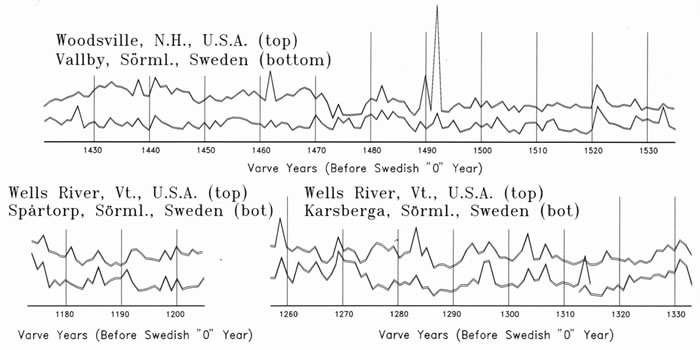
Modified from De Geer (1921)
Antevs' Post-New England Years
After assembling varve sequences in Canada (Antevs, 1925, 1931b) and adding to his work in the northeastern U.S. (Antevs, 1928), Ernst Antevs focused his research on more regional and global syntheses of deglaciation (Antevs, 1931a, 1934, 1936, 1943, 1945, 1953, 1954, 1955, 1957, 1962) as well as the geomorphology and history of climate change associated with early human occupation sites in the southwestern U.S (see Haynes, 1990 for references). Except for a brief study of varves at a mining excavation in Ontario (Antevs, 1951), Antevs left the field of glacial varve chronology.
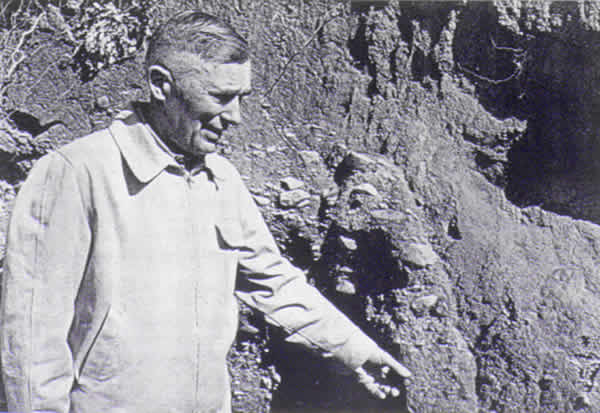
Ernst Antevs in Arizona (1953), from Haynes (1990)
Varve Chronology and the Advent of Radiocarbon Techniques
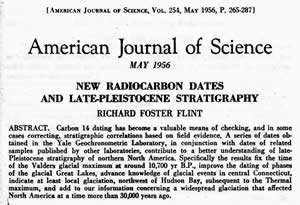
Flint (1956)
Varve chronology in North America took a final blow with the first application of radiocarbon ages to the history of deglaciation in New England. Flint (1956) interpreted two sets of radiocarbon ages as bracketing the age of Lake Hitchcock (or the lake in the Connecticut Valley at Hartford) to 12,700-10,700 14C yr BP. At the time this seemed to dispute the over 4800 years of varves representing this lake in Antevs' New England Varve Chronology.
Based on what we know today, both of Flint's limiting ages for Lake Hitchcock do not appear to have any relationship to age constraints on lakes in the Connecticut Valley. The limiting maximum age (12,700 14C yr ago) is from a core of a modern lake south of Hartford and provides age control for a spruce pollen zone. This age cannot be tied to the formation of lakes north of Hartford or the varve chronology. The younger limiting age for the lake (10,700 14 yr BP) is from a gravel that was interpreted by Flint (1956) to be a spillway deposit of Lake Hitchcock at New Britain, thus marking a time of the existence of Lake Hitchcock at Hartford. This seems unlikely, if not impossible, given more recent age constraints for Lake Hitchcock's drainage (Stone et al., 2005) and new radiocarbon ages for the New England Varve Chronology (Ridge, 2004; See 14C Data Download page).
Today we view the age of lakes in the Connecticut Valley differently as indicated by radiocarbon-dated material from the varve sequence itself. New radiocarbon ages indicate that Antevs' original New England Varve Chronology in the Connecticut Valley (NE 2868-7750 including the 248-yr Claremont Gap) spans a radiocarbon age of ~14,800-11,200 14C yr BP. The new radiocarbon ages must be calibrated for a fair comparison to varve years. When this is done the New England Varve Chronology's ~4800 years in the Connecticut Valley spans 17,800-13,100 calibrated yr BP. This is in agreement with Antevs' varve count given the minor uncertainties of the span of the Claremont Gap and the precision of radiocarbon dating.
Unfortunately, Flint's (1956) interpretations of radiocarbon ages in New England were disastrous for varve chronology in North America. Not only did the radiocarbon ages apparently invalidate the varve count, but it prompted Flint to omit mention and references of New England varve work from the later two editions of his comprehensive textbook on glacial and Quaternary geology (Flint, 1957, 1971). For over 20 years these books were used by almost every student in glacial geology in North America as textbooks and comprehensive bibliographies. As a result, skepticism over the use of varve chronology became firmly cemented in the minds of most Quaternary geologists in North America as the subject generally lost visibility and was largely dismissed. Through the 1970's more advanced study of varve chronology in New England as a chronologic tool was hampered by an inability to calibrate the varves using radiocarbon ages. Although plant fossils were sometimes found in the varves the organic carbon mass of these samples was rarely enough to provide material for age determinations until the advent of AMS radiocarbon dating in the 1980's.

Glacial and Quaternary Textbooks, R.F. Flint
An NEVC Revival
Despite the general disregard for varve chronology in North America there were a few geologists who persisted and used the chronology for more advanced studies. In all of these works researchers were able to exactly match new measured sections to Antevs' chronologies (for example Lougee, 1935). Standing out in this work are geophysicists who used the New England Varve Chronology as a time scale for constructing records of secular variation of the geomagnetic field (McNish and Johnson, 1938; Johnson et al., 1948; Verosub, 1979a, 1979b) and the investigation of the paleomagnetism of various types of glacial sediment (Thomas, 1984). Unfortunately, it would not be until the 1990's with the calibration of the New England Varve Chronology and its re-application to deglaciation history that varve chronology in North America would again gain widespread interest and acceptance. View the NEVC Today pages.
References
- Antevs, Ernst, 1922, The recession of the last ice sheet in New England: American Geographical Society Research Series, no. 11, 120 p. (with a preface and contributions by J.W. Goldthwait).
- Antevs, Ernst, 1925, Retreat of the last ice-sheet in eastern Canada: Canadian Geological Survey Memoir no. 146, 142 p.
- Antevs, Ernst, 1928, The last glaciation, with special reference to the ice sheet in northeastern North America: American Geographical Society Research Series, no. 17, 292 p.
- Antevs, Ernst, 1931a, Late Glacial clay chronology of North America: Annual Report of the Board of Regents of the Smithsonian Institution for the Year Ended June 30, 1931, p. 313-326.
- Antevs, Ernst, 1931b, Late-glacial correlations and ice recession in Manitoba: Geological Survey of Canada Memoir no. 168, 76 p.
- Antevs, Ernst, 1934, Climaxes of the last glaciation in North America: American Journal of Science, v. 28, no. 166, p. 304-311.
- Antevs, Ernst, 1935, Telecorrelations of varve curves: Geologiske Foreningens i Stockholm Forhandlingar, v. 57, h. 1, p. 47-58.
- Antevs, Ernst, 1936, Correlations of late Quaternary chronologies: 16th International Geological Congress in 1933, Reports, v. 1, p. 213-216.
- Antevs, E., 1938, Climatic variation during the last glaciation in North America: Bulletin of the American Meteorological Society, v. 19, p. 172-176.
- Antevs, Ernst, 1939, Modes of retreat of the Pleistocene ice sheets: Journal of Geology, v. 47, no. 5, p. 503-508.
- Antevs, Ernst, 1943, Climaxes of the last glaciation in North America: American journal of Science, 5th series, v. 28, no. 166, p. 304-311.
- Antevs, E., 1945, Correlation of Wisconsin glacial maxima: American Journal of Science, v. 243-A, Daly Volume, p. 1-39.
- Antevs, Ernst, 1951, Glacial clays in Steep Rock Lake, Ontario, Canada: Geological Society of America Bulletin, v. 62, no. 10, p. 1223-1262.
- Antevs, E., 1953, Geochronology of the deglacial and neothermal ages: Journal of Geology, v. 61, no. 3, p. 195-230.
- Antevs, E., 1954, Chronology of the deglacial and neothermal ages: a reply: Journal of Geology, v. 62, no. 5, p. 516-521.
- Antevs, E., 1955, Varve and radiocarbon chronologies appraised by pollen data: Journal of Geology, v. 63, no. 5, p. 495-499.
- Antevs, E., 1957, Geological tests of the varve and radiocarbon chronologies: Journal of Geology, v. 65, no. 2, p. 129-148.
- Antevs, E., 1962, Transatlantic climatic agreement versus C14 dates: Journal of Geology, v. 70, no. 2, p. 194-205.
- De Geer, G., 1921, Correlation of late glacial annual clay-varves in North America with the Swedish time scale: Geologiska Foreningens i Stockholm Forhandlingar, v. 43, h. 1-2, p. 70-73.
- De Geer, G., 1926, On the solar curve as dating the ice age, the New York moraine, and Niagara Falls through the Swedish timescale: Geografiska Annaler, v. 8, p. 252-284.
- De Geer, G., 1927, Late glacial clay varves in Argentina measured by Dr. Carl Caldenius, dated and connected with the solar curve through the Swedish timescale: Geografiska Annaler, v. 9, p. 1-8.
- De Geer, G., 1929, Gotiglacial clay-varves in southern Chile measured by Dr. Carl Caldenius, identified with synchronous varves in Sweden, Finland, and U.S.A.: Geografiska Annaler, v. 11, p. 247-256.
- De Geer, G., 1930, The Finiglacial subepcoch in Sweden, Finland and the new world: Geografiska Annaler, v. 12, p. 101-111.
- De Geer, G., 1934a, Equatorial Palaeolithic varves in East Africa measured in 1929 and 1933 by Erik Nilsson, teleconnected with the Swedish time scale: Geografiska Annaler, v. 16, p. 75-96.
- De Geer, G., 1934b, Geology and geochronology: Geografiska Annaler, v. 16, p. 1-52.
- De Geer, G., 1940, Geochronologia Suecica principles: Kungl. Svenska Vetenskapsakademiens Handlingar, Tredje Series, Band 18, no. 6, 357 p. and Atlas of plates.
- Flint, R.F., 1929. The stagnation and dissipation of the last ice sheet. Geographical Review 19, 256-289.
- Flint. R.F., 1930, The glacial geology of Connecticut: Connecticut State Geological and Natural History Survey Bulletin no. 47, 294 p.
- Flint, R.F., 1932. Deglaciation of the Connecticut Valley. American Journal of Science 24, 152-156.
- Flint, R.F., 1933, Late Pleistocene sequence in the Connecticut Valley: Geological Society of America Bulletin, v. 44, p. 965-988.
- Flint, R.F., 1947, Glacial geology and the Pleistocene epoch: New York, John Wiley and Sons, 589 p.
- Flint, R.F., 1956, New radiocarbon dates and late Pleistocene stratigraphy: American Journal of Science, v. 254, p. 265-287.
- Flint, R.F., 1957, Glacial and Pleistocene geology: New York, John Wiley and Sons, 553 p.
- Flint, R.F., 1971, Glacial and Quaternary geology: New York, John Wiley and Sons, 892 p.
- Goldthwait, J.W., 1916. Glaciation in the White Mountains of New Hampshire. Geological Society of America Bulletin 27, 263-294.
- Goldthwait, J.W., 1938. The uncovering of New Hampshire by the last ice sheet. American Journal of Science 36, 345-372.
- Haynes, C. Vance, Jr., 1990, The Antevs-Bryan years and the legacy for paleoindian geochronology, in Laporte, L.F., ed., Establishment of a geologic framework for paleoanthropology: Geological Society of America Special Paper no. 242, p. 55-68.
- Jahns, R.H., Willard, M., 1942, The Pleistocene and recent deposits in the Connecticut Valley, Massachusetts: American Journal of Science 240, 161-191 and 265-287.
- Lougee, R.J., 1940, Deglaciation of New England: Journal of Geomorphology 3, 189-217.
- Jahns, R.H., Willard, M., 1942, The Pleistocene and recent deposits in the Connecticut Valley, Massachusetts: American Journal of Science 240, 161-191 and 265-287.
- Johnson, E.A., Murphy, T., and Torreson, O.W., 1948, Prehistory of the Earth's magnetic field: Terrestrial Magnetism and Atmospheric Electricity (now Journal of Geophysical Research), v. 53, p. 349-372.
- Koteff, C., 1974, The morphologic sequence concept and deglaciation of southern New England. In: Coates, D.R., ed., Glacial Geomorphology. Publications in Geomorphology, State University of New York, Binghamton, pp. 121-144.
- Koteff, C. and Pessl, F., Jr., 1981, Systematic ice retreat in New England: United States Geological Survey, Professional Paper 1179, 20 pp.
- Lougee, R.J., 1935, Time measurements of an ice readvance at Littleton, N.H.: Proceedings of the National Academy of Sciences, v. 21, p. 36-41.
- Lougee, R.J., 1940, Deglaciation of New England: Journal of Geomorphology, v. 3, p. 189-217.
- McNish, A.G. and Johnson, E.A., 1938. Magnetization of unmetamorphosed varves and marine sediments. Terrestrial Magnetism and Atmospheric Electricity (now Journal of Geophysical Research), 43: 401-407.
- Reeds, C.A., 1926, The varved clays at Little Ferry, New Jersey: American Museum Novitates no. 209, 16 p.
- Ridge, J.C., and Toll, N.J., 1999, Are late-glacial climate oscillations recorded in varves of the upper Connecticut Valley, Northeastern United States?: Geologiska Foreningens i Stockholm Forhandlingar, v.121, p.187-193.
- Ridge, J.C., Besonen, M.R., Brochu, M., Brown, S.L., Callahan, J.W., Cook, G.J., Nicholson, R.S., and Toll, N.J., 1999, Varve, Paleomagnetic, and 14C Chronologies for Late Pleistocene Events in New Hampshire and Vermont, U.S.A.: G�ographie physique et Quaternaire, v.53, 79-108.
- Ridge, J.C., 2004, The Quaternary glaciation of western New England with correlations to surrounding areas, in Ehlers, J. & Gibbard, P.L. (eds.), Quaternary Glaciations - Extent and Chronology, Part II: North America. Developments in Quaternary Science, vol. 2b, Amsterdam, Elsevier, p. 163-193.
- Stone, J.R., Stone, B.D., DiGiacomo-Cohen, M.L., Lewis, R.S., Ridge, J.C., and Benner, J.S., 2005, The new Quaternary map of Connecticut and Long Island Sound basin, Part 2 - Illustrated by a field trip in the Connecticut River Valley. In Skinner, B.J. and Philpotts, A.R., eds., Guidebook for Field Trips in Connecticut, 97th New England Intercollegiate Geological Conference: New Haven, Connecticut, p. 131-160.
- Thomas, G.M., 1984. A comparison of the paleomagnetic character of some varves and tills from the Connecticut Valley. MS thesis, University of Massachusetts, Amherst, 136 p.
- Verosub, K.L., 1979a, Paleomagnetism of varved sediments from western New England: Secular variation: Geophysical Research Letters, v. 6, p. 245-248.
- Verosub, K.L., 1979b, Paleomagnetism of varved sediments from western New England: Variability of the recorder: Geophysical Research Letters, v. 6, p. 241-244.
- Wohlfarth, B., Bj�rck, S., Cato, I., and Possnert, G., 1997, A new middle Holocene varve diagram from the River �ngerman�lvan, northern Sweden: indications for a possible error in the Holocene varve chronology: Boreas, v. 26, p. 347-353.


